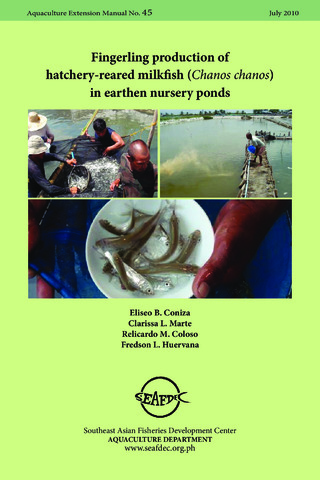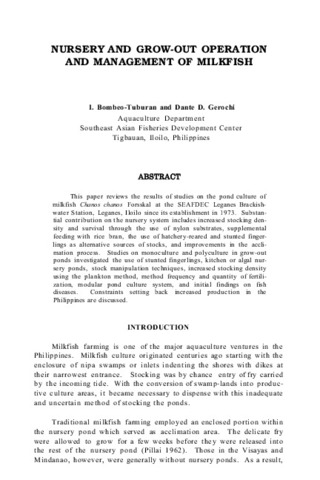Fingerling production of hatchery-reared milkfish (Chanos chanos) in earthen nursery ponds
- Global styles
- MLA
- Vancouver
- Elsevier - Harvard
- APA
- Help

View/
Date
2010Page views
24,510ASFA keyword
AGROVOC keyword
Taxonomic term
Metadata
Show full item record
Share
Abstract
Fingerling production of milkfish in ponds maybe operated as a commercial enterprise or a component of milkfish farming that comprises nursery, transition and rearing or grow-out phases. The fishpond nursery is used to grow milkfish fry to fingerlings 1-3 g in weight or 1-2 inches in length. The nursery pond is the smallest of the major fishpond compartment ranging from 500 to 5,000 m2, and is about 10% of the total farming area. The pond is prepared with utmost care to eliminate predators and competitors. The area should have good topography, is free from flooding and should have soil with good water retention properties for good dike construction and efficient culture management. Water supply should be adequate year-round and free from pollutants. Good pond water quality is maintained and natural food should be adequate to enhance growth and survival. With high stocking densities, supplemental feed is also provided. The three types of nurseries are based on feed sources: lablab, plankton with supplemental feeding and direct feeding. Select hatchery-reared fry (21 day old) that swim actively in schools, are uniform in size, have robust body, and are resistant to handling and transport stress. The ideal fry stocking density is 5-40 pieces/m2. Survival ranging from 50-90% can be expected after 25-45 days of rearing. Harvest, packing, transport, acclimation and stocking of the fry or fingerlings are carefully done during the cooler part of the day. Economic indicators show that fingerlings production is a profitable business. The improvement of milkfish grow-out technology from extensive or traditional to modified-extensive, semi-intensive and intensive culture in ponds, pens or in sea cages has increased demand for good quality fingerlings. Mass production of hatchery-reared fingerlings in earthen nursery ponds during peak season of fry availability can help bridge the supply gap. A steady supply of fingerlings for a whole year s operation will further increase production and ensure a sustainable supply of affordable market-sized fish.
Type
BookISSN
0115-5369Series
Aquaculture extension manual No. 45Format
[iv], 30 p. : ill.
Collections
Related items
Showing items related by title, author, creator and subject.
-
Ongoing research studies on maturation and spawning of milkfish, Chanos chanos at the brackishwater shrimp and milkfish culture applied research and training project, Jepara, Indonesia
Alikunhi, K. H. (Aquaculture Department, Southeast Asian Fisheries Development Center, 1976)The paper gives an account of the research work carried out at Jepara, Indonesia, on induction of maturity of milkfish in ponds and enclosures, and procurement of the spawners from the wild for seed production by hypophysation. ... -
Series: Milkfish Podcasts
Milkfish aquaculture: Alternate-day feeding strategy for reducing cost of milkfish culture in brackishwater ponds and marine cages in the Philippines
Sayco, Roberto; de Jesus-Ayson, Evelyn Grace (AquaFish Collaborative Research Support Program (AquaFish CRSP), 2012-02-02)This podcast provides information on how an alternate-day feeding strategy can be used to reduce costs for culturing milkfish in ponds or marine cages. -
Nursery and grow-out operation and management of milkfish
Bombeo-Tuburan, Isidra.; Gerochi, Dante D. (Aquaculture Department, Southeast Asian Fisheries Development Center, 1988)This paper reviews the results of studies on the pond culture of milkfish Chanos chanos Forsskal at the SEAFDEC Leganes Brackishwater Station, Leganes, Iloilo since its establishment in 1973. Substantial contribution on ...





